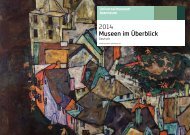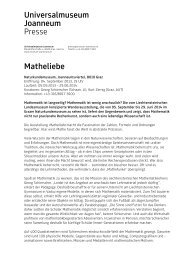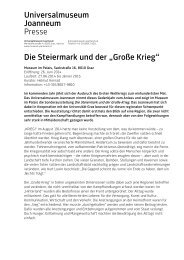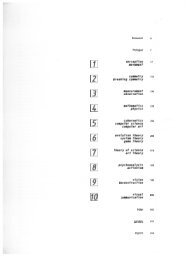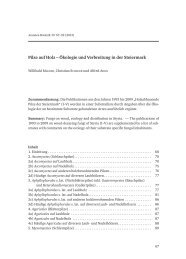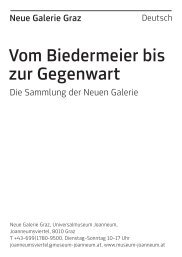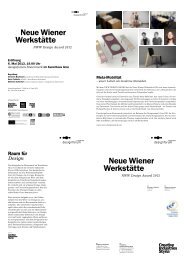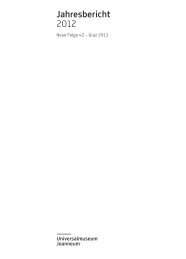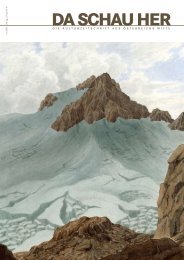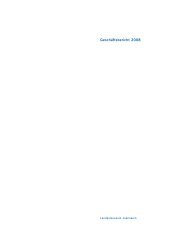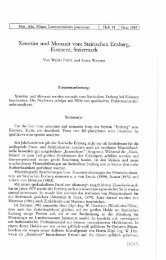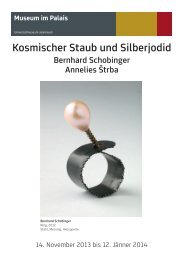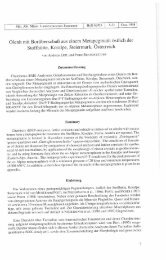Diana Thater gorillagorillagorilla - Universalmuseum Joanneum
Diana Thater gorillagorillagorilla - Universalmuseum Joanneum
Diana Thater gorillagorillagorilla - Universalmuseum Joanneum
Sie wollen auch ein ePaper? Erhöhen Sie die Reichweite Ihrer Titel.
YUMPU macht aus Druck-PDFs automatisch weboptimierte ePaper, die Google liebt.
Hollis Frampton,<br />
Zorns Lemma, 1970 (film stills)<br />
verschiebbare konzipiert und bevorzugt feststehende Zeugen<br />
darauf malt.“ Deleuze untersucht die Methode des Malers und<br />
entdeckt, dass Bacon aus dem Triptychon mehr macht. „Mehr<br />
als ein Möbel, macht er aus ihm das Äquivalent der Sätze oder<br />
der Parts eines Musikstücks. Das Triptychon wäre die Verteilung<br />
dreier Grundrhythmen (aktiv, passiv, Zeuge). Es gibt eine zirkuläre<br />
– und weniger lineare – Organisation des Triptychons.“25<br />
Die Komposition von Rhythmen innerhalb des strukturellen Felds<br />
eines Triptychons ist ein Träger der Sensationen – Intensitäten<br />
und reinen Unterschieden der Sinneserfahrung – und ermöglicht<br />
auf diese Weise einen Austausch, der folglich zur Verschmelzung<br />
des einen mit dem anderen und zur Entstehung einer konzeptuellen<br />
Kategorie führt.<br />
Der Rhythmus ist der Handlungsträger, er verhandelt zwischen<br />
der Sensation und der Figur und kartiert die autonome Zone<br />
neuer Subjektivitäten. „In der einfachen Sensation aber hängt<br />
der Rhythmus noch von der Figur ab, er präsentiert sich als<br />
Schwingung, die den organlosen Körper durchläuft, er ist der<br />
Vektor der Sensation, das, was sie von einer Ebene zur anderen<br />
treibt. In der Sensationskopplung befreit sich der Rhythmus<br />
bereits, weil er die unterschiedlichen Ebenen verschiedener Sensationen<br />
gegeneinanderstellt und vereinigt: Er ist nun Resonanz,<br />
verschmilzt aber noch mit den melodischen Linien, Punkten und<br />
Kontrapunkten eines Figurenpaars; er ist das Diagramm des<br />
Figurenpaars. Mit dem Triptychon schließlich erreicht der Rhythmus<br />
eine außergewöhnliche Amplitude in einer erzwungenen<br />
Bewegung, die ihm Autonomie verleiht und in uns den Eindruck<br />
von Zeit entstehen lässt: Die Grenzen der Sensation werden in<br />
alle Richtungen gesprengt und überstiegen; die Figuren werden<br />
emporgehoben oder in die Luft geschleudert, auf luftige Turngeräte<br />
gesetzt, von denen sie plötzlich herabfallen. Zugleich aber<br />
entsteht in diesem immobilen Sturz das seltsamste Phänomen<br />
von Rekomposition und Neuverteilung, denn der Rhythmus wird<br />
selbst Sensation, er selbst wird Figur gemäß seinen eigenen,<br />
voneinander getrennten Richtungen, aktiv, passiv und Zeuge …“26<br />
An der Schwelle zwischen Figürlichkeit und Abstraktion, Repräsentation<br />
und Performance, stellt das malerische Schaffen von<br />
Francis Bacon – und hier besonders die Triptychen und deren<br />
rhythmische Gestalt – wohl eine geeignete Referenz für <strong>Diana</strong><br />
<strong>Thater</strong>s Mehrfachbild-Videodiagramme dar. Auch hier ist der<br />
Raum der Installation, der immer aus mehreren sich teilweise<br />
überlappenden Projektionen, Plasmabildschirmen und Monitoren<br />
komponiert ist und der Choreografie eines vorgegeben Innenraums<br />
folgt und mit ihm interagiert, ein Spielplatz der Rhythmen,<br />
Adam Budak 20 21<br />
who thinks of his paintings as movable objects, and<br />
likes to paint constant attendants to them.” Deleuze<br />
investigates the painter’s method and discovers that<br />
Bacon “makes the triptych equivalent to the movements<br />
or parts of a piece of music more than a piece<br />
of furniture. The triptych would be the distribution of<br />
the three basic rhythms (active, passive, attendant).<br />
There is a circular organization in the triptych, rather<br />
than a linear one.”25 Composition of rhythms within<br />
the structural field of a triptych is a vehicle of sensations<br />
– intensities and pure differences of sensory<br />
experience – and as such it facilitates a traffic that<br />
consequently leads towards the merging of one with<br />
another and becoming one conceptual category.<br />
Rhythm is the agent of action, negotiating between<br />
the sensation and the Figure and mapping the autonomous<br />
zone of new subjectivities: “But in the simple<br />
sensation, rhythm is still dependent on the Figure; it<br />
appears as the vibration that flows through the body<br />
without organs, it is the vector of the sensation, it<br />
is what makes the sensation pass from one level to<br />
another. In the coupling of sensation, rhythm is already<br />
liberated, because it confronts and unites the divers<br />
levels of different sensations: it is now resonance, but<br />
it is still merged together with the melodic lines, the<br />
points and counterpoints of a coupled Figure; it is<br />
the diagram of the coupled Figure. With the triptych,<br />
finally, rhythm takes on an extraordinary amplitude<br />
in a forced movement which gives it an autonomy,<br />
and produces in us the impression of time: the limits<br />
of sensation are broken, exceeded in all directions;<br />
the Figures are lifted up, or thrown in the air, placed<br />
upon aerial riggings from which they suddenly fall.<br />
But at the same time, in this immobile fall, the strangest<br />
phenomenon of recomposition or redistribution<br />
is produced, for it is the rhythm itself that becomes<br />
sensation, it is rhythm that becomes Figure, according<br />
to its own separated directions, the active, the passive,<br />
and the attendant …”26<br />
Located on the threshold between figuration and<br />
abstraction, representation and performance, the<br />
painterly work of Francis Bacon – and especially the<br />
triptychs and their rhythmic Gestalt – constitute an<br />
apt reference for the multi-image video diagrams of



